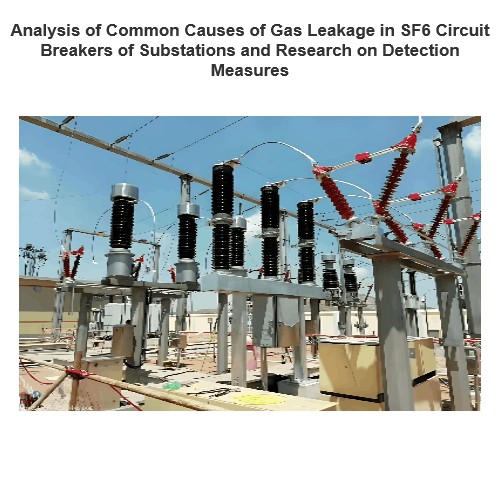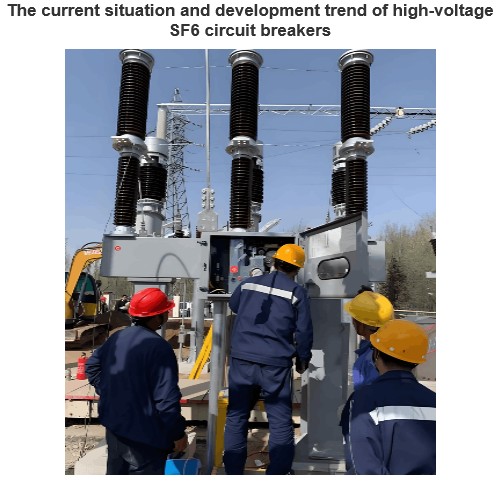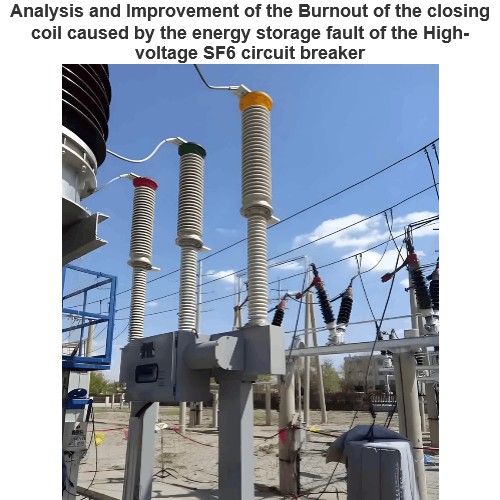In an SF₆ circuit breaker, the SF₆ gas can decompose into toxic and corrosive gases and water in a high-temperature environment, which can damage the insulating layer. To prevent this situation, while effectively strengthening the protection of electrical components, the insulation level should also be improved. In addition, faults should be analyzed, and corresponding measures should be taken for treatment.
1 Case Analysis
A 110 kV switch in a substation was struck by lightning, causing a reclosing problem in the switch interval. Judging from the appearance of the switch, there are no abnormal phenomena. However, after testing the circuit breaker, it is found that the current of phase A is much higher than that of phase B and phase C. The personnel of the test class in the substation inspected the circuit breaker. The inspection was carried out through experiments, and the contents mainly include the insulation resistance, the operating characteristics of the switch, the loop resistance, and an AC withstand voltage test. Through this detection method, the arc fault inside the switch can be inspected, and the components of the SF₆ gas in the circuit breaker switch can also be tested. The circuit breaker in this interval is produced by SIEMENS in Hangzhou, and the model is 3AP1FG. The test results obtained by inspecting the switch of the circuit breaker interval are as follows:
- The insulation resistance of the switch connected to the CT: phase A is 22.5 G, phase B is 17.4 G, and phase C is 17.8 G.
- The operating characteristics of the circuit breaker switch, according to the content of the product's production report, the closing time is 65 ms; the opening time is 18 ms. The results obtained through detection are as follows: for phase A, the closing time is 61.1 ms, and the opening time is 16.8 ms; for phase B, the closing time is 61.1 ms, and the opening time is 16.1 ms; for phase C, the closing time is 58.9 ms, and the opening time is 16.4 ms. The closing synchronism is 1.2 ms; the opening synchronism is 0.3 ms.
- The result of the AC withstand voltage test on the switch disconnector: 75 kV, 1 minute, passed.
- The test of the gas components in the SF₆ of the switch shows that for phase A, sulfur dioxide is 4.13 l/L, and hydrogen sulfide is 3.15 l/L; for phase B, sulfur dioxide is 0 l/L, and hydrogen sulfide is 0 l/L; for phase C, sulfur dioxide is 0 l/L, and hydrogen sulfide is 0 l/L. According to the relevant regulations in the preventive test procedures for electrical equipment, the content of sulfur dioxide should be lower than 3 l/L, and the content of hydrogen sulfide should be lower than 2 l/L. The test results of the SF₆ gas components of the phase A switch show that it has exceeded the specified value, so the testers need to pay attention to this.
- The test of the loop resistance of the circuit breaker switch. According to the relevant regulations in the test procedures, the measured value should be lower than 120% of the value specified by the manufacturer. The loop resistance tester is used for this test, and the data obtained through three tests are as follows: the first test result: phase A is 1368 μΩ; phase B is 694 μΩ; phase C is 579 μΩ; the second test result: phase A is 38 μΩ; phase B is 36 μΩ; phase C is 35 μΩ; the third test result: phase A is 38 μΩ; phase B is 39 μΩ; phase C is 38 μΩ.
By analyzing the data information obtained from the test, some characteristics can be identified: Firstly, the test value of phase A is much higher than that of phase B and phase C, and it even exceeds 1000 μΩ, which has seriously exceeded the normal resistance value. Secondly, from the results of the three tests, the test results of phase A vary greatly and are very unstable, and there is almost no repeatability in the three tests. Thirdly, comparing the test results between phase A, phase B, and phase C, the values have a large difference. Fourthly, the test result of phase A has increased significantly compared with previous tests. Through the test method and the analysis of the obtained data information, it can be determined that the insulation effect of phase A of the circuit breaker is good, and the operating characteristics of the circuit breaker switch comply with the relevant regulations. However, the SF₆ gas components of the phase A switch seriously exceed the specified standard, and the loop resistance exceeds the specified standard. Therefore, after disassembly and analysis, the characteristics of the circuit breaker are as follows: Firstly, there is black powder attached to the contacts of phase A. Although the amount is not large, the burrs and fuzz on the surface are very obvious. Secondly, traces of arc burning are found at the moving contacts.
2 Faults of SF₆ Circuit Breaker and the Causes of Faults
The above case is a fault of the switch of the SF₆ circuit breaker, manifested as a reclosing problem. When a faulty circuit breaker continues to be used, the existence of such a switch fault can lead to refusal-to-operate, misoperation faults, and insulation faults, which are very harmful.
2.1 Refusal-to-operate and Misoperation Faults of SF₆ Circuit Breaker
The refusal-to-operate of the SF₆ circuit breaker, that is, refusal-to-open and refusal-to-close, means that the circuit breaker does not perform corresponding actions after the opening or closing signal is sent. The misoperation of the circuit breaker means that the circuit breaker performs opening or closing actions without receiving an operation command, and it is also possible that the actions of the circuit breaker do not conform to the operation command. The SF₆ circuit breaker may also have the problem of "unauthorized tripping", that is, the protection device does not send an action signal, and the circuit breaker automatically trips without manual operation. There are many reasons for the refusal-to-operate or misoperation problems of the circuit breaker, such as mechanical faults of the circuit breaker, faults of electrical equipment, and faults of relay protection devices.
2.2 Insulation Faults of SF₆ Circuit Breaker
If the circuit breaker has insulation faults, SF₆ gas leakage will occur, and mechanical faults will also be caused, mainly manifested as internal insulation flashover breakdown to the ground, flashover breakdown caused by overvoltage due to lightning, capacitive bushing flashover, external insulation flashover breakdown to the ground, and flashover of porcelain bushings and insulating rods.
2.3 Main Causes of Refusal-to-operate and Misoperation Faults
The mechanical cause of the refusal-to-operate fault of the circuit breaker is that there are omissions in the production, installation, debugging, or technical maintenance of the circuit breaker, leading to quality problems. The refusal-to-operate of the circuit breaker caused by such mechanical faults accounts for more than 60% of all refusal-to-operate faults of the circuit breaker. The faults of the circuit breaker caused by electrical reasons are mainly manifested as problems in secondary wiring, jamming of the opening and closing iron cores, burnout of coils, burnout of the opening loop resistance, faults of the locking relay protection device, faults of the operating power supply, and faults of auxiliary switches.
2.4 Causes of Insulation Faults
The causes of internal insulation faults of the circuit breaker include the presence of metal objects inside the circuit breaker, which leads to conduction and discharge faults; the presence of a floating potential inside the circuit breaker, which causes discharge faults; flashover faults along the surface of the insulating parts of the circuit breaker, and imperfect design of the insulating parts. The causes of external insulation faults of the circuit breaker are that the creepage distance of the external insulation of the porcelain bushing does not meet the specified standard, and in terms of appearance, the specifications do not meet the requirements, which is likely to cause external insulation flashover of the porcelain bushing. If there are quality problems in the manufacture of the porcelain bushing and the working environment is dirty, insulation flashover will also occur.
3 Treatment Methods for SF₆ Circuit Breaker Faults
3.1 Measuring the Resistance of the Main Circuit
When the switch of the circuit breaker is in the closing state, measure the resistance of the main circuit between the incoming line and the outgoing line. The current can be any value between 100 A and the rated current. If the casing of the grounding switch's conductive rod can be effectively isolated from the insulation, the parallel resistance of the conductor casing can be measured, and the DC resistance of the conductor casing can also be measured.
3.2 Performing an AC Withstand Voltage Test on the Circuit Breaker
Performing an AC withstand voltage test on the circuit breaker can reveal the defects of the test specimen. Simulate the operation of the test specimen to understand its ability to withstand overvoltage. When inspecting various impurities of free conductive particles, the sensitivity of the AC voltage is very high.
3.3 Conducting Routine Inspections and Experimental Tests
To avoid faults during the operation of the circuit breaker, routine inspections and experimental tests should be carried out, including checking the rated operating voltage of the circuit breaker and testing its time characteristics. When checking the mechanical characteristics of the circuit breaker, all mechanical components should be inspected, and the appearance of the operating mechanism should also be inspected to ensure that the opening and closing coils are in good condition.
3.4 Testing the Circuit Breaker Using the Disassembly and Chemical Method
When the circuit breaker is in normal operation, SF₆ does not react chemically with metallic materials and organic solid materials. Arc discharge can play a catalytic role, resulting in chemical reactions. When detecting the decomposition products of SF₆ gas, the main chemical components to be detected include sulfur dioxide, hydrogen sulfide, methane, and carbon monoxide. By analyzing the concentration of the gas, potential hidden faults of the SF₆ circuit breaker can be judged.
4 Conclusion
In conclusion, the SF₆ circuit breaker plays an increasingly important role in the power system. Effectively maintaining the normal operation of the SF₆ circuit breaker is crucial for the safe operation of the system. For operation and maintenance personnel, understanding the performance of the circuit breaker, recognizing the causes of faults, and finding reasonable treatment methods according to the causes have become necessary professional skills to ensure the safe operation of the power system.













